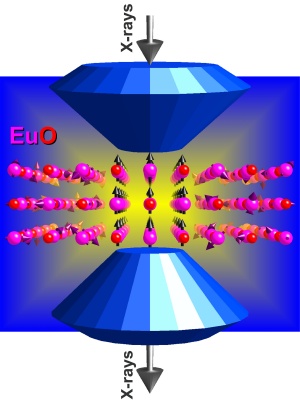Feb 25 2009
When squeezed, electrons increase their ability to move around. In compounds such as semiconductors and electrical insulators, such squeezing can dramatically change the electrical and magnetic properties.
 A ferromagnetic-semiconductor Europium oxide sample is subjected to high pressures in a diamond anvil cell. The electronic structure is simultaneously probed with circularly-polarized x-rays at the Advanced Photon Source, revealing the mechanism responsible for the strengthening of magnetic interactions under pressure.
A ferromagnetic-semiconductor Europium oxide sample is subjected to high pressures in a diamond anvil cell. The electronic structure is simultaneously probed with circularly-polarized x-rays at the Advanced Photon Source, revealing the mechanism responsible for the strengthening of magnetic interactions under pressure.
Under ambient pressure, europium oxide (EuO) becomes ferromagnetic only below 69 Kelvin, limiting its applications. However, its magnetic ordering temperature is known to increase with pressure, reaching 200 Kelvin when squeezed by 150,000 atmospheres. The relevant changes in electronic structure responsible for such dramatic changes, however, remained elusive until recently.
Now scientists at the U.S. Department of Energy's Argonne National Laboratory have manipulated electron mobility and pinpointed the mechanism controlling the strength of magnetic interactions and, hence, the material's magnetic ordering temperature.
"EuO is a ferromagnetic semiconductor and is a material that can carry spin polarized currents, which is an integral element of future devices aimed at manipulating both the spin and the charge of electrons in new generation microelectronics," said Argonne postdoctoral researcher Narcizo Souza-Neto.
Using powerful X-rays from the Advanced Photon Source to probe the material's electronic structure under pressure, Souza-Neto and Argonne physicist Daniel Haskel reported in the February 6 issue of Physical Review Letters that localized, 100 percent polarized Eu 4f electrons become mobile under pressure by hybridizing with neighboring, extended electronic states. The increased mobility enhances the indirect magnetic coupling between Eu spins resulting in a three-fold increase in the ordering temperature. The paper, "Pressure-induced electronic mixing and enhancement of ferromagnetic ordering in EuX (X=O,S,Se,Te) magnetic semiconductors," is available online.
While the need for large applied pressures may seem a burden for applications, large compressive strains can be generated at interfacial regions in EuO films by varying the mismatch in lattice parameter with selected substrates. By pinpointing the mechanism the research provides a road map for manipulating the ordering temperatures in this and related materials, e.g., through strain or chemical substitutions with the ultimate goal of reaching 300 Kelvin (room temperature).
"Manipulation of strain," Haskel said, "adds a new dimension to the design of novel devices based on injection, transport and detection of high spin-polarized currents in magnetic/semiconductor hybrid structures."
Other authors in the paper are graduate student Yuan-Chieh Tseng (Northwestern University) and Gerard Lapertot (CEA-Grenoble).
Funding for this research was provided by the U.S. Department of Energy's Office of Science, the single largest supporter of basic research in the physical sciences in the United States.